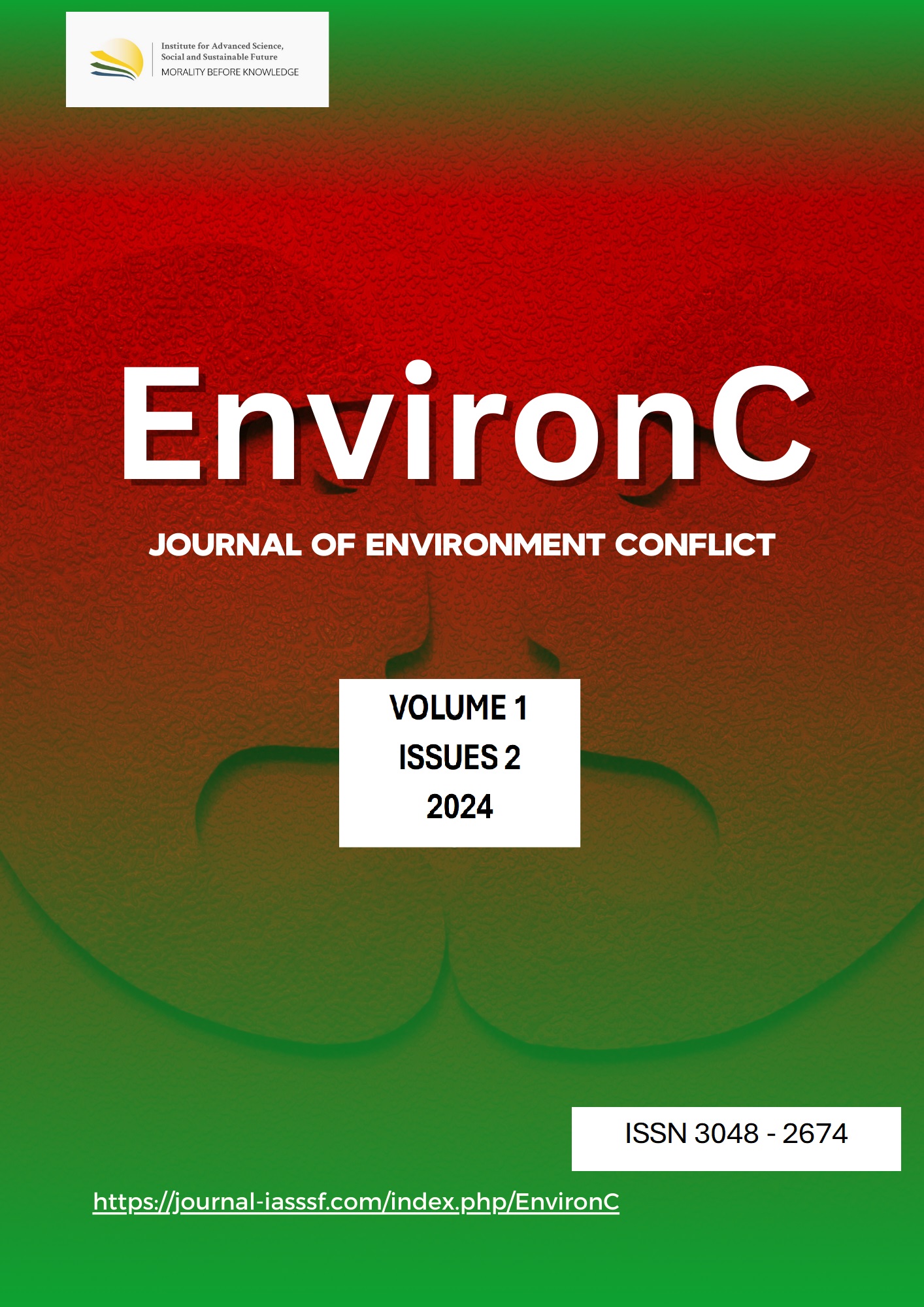Strategi mengurangi emisi gas rumah kaca untuk mengatasi konflik global akibat perubahan iklim
DOI:
https://doi.org/10.61511/environc.v1i2.2024.1176Keywords:
greenhouse gas emissions, climate change, global conflict, mitigation, adaptationAbstract
Background: Greenhouse gas (GHG) emissions, such as methane and CO₂, are major contributors to global temperature rise as they trap heat from the sun that would otherwise reflect out of Earth’s atmosphere, leading to global warming. The impacts of these emissions include sea level rise, climate change, and disruptions to economic, social, educational, and food security sectors. Human activities, particularly in industry, livestock, agriculture, transportation, and waste management, significantly contribute to carbon emissions, making mitigation and adaptation measures essential. Method: This study employs a literature review, gathering data from scientific articles, news sources, international agreements, and other publications to understand the impacts of GHG and response strategies. Findings: Identified mitigation solutions include shifts to renewable energy, improvements in energy efficiency, and enhanced waste management. Adaptation efforts, such as climate-resilient infrastructure and sustainable agricultural practices, have also been implemented. However, challenges remain in local implementation and funding gaps. Conclusion: The study concludes that successful GHG reduction and climate change management require a synergy between mitigation and adaptation. International and cross-sectoral collaboration is crucial for long-term environmental sustainability. Novelty/Originality of this article: This article provides an in-depth analysis of the synergy between mitigation and adaptation efforts at various levels, identifies implementation challenges, and presents opportunities for innovative collaborative strategies not widely discussed in previous studies.
References
Anggraeni, D. Y. (2015). Pengungkapan emisi gas rumah kaca, kinerja lingkungan, dan nilai perusahaan. Jurnal Akuntansi dan Keuangan Indonesia, 12(2), 5. https://doi.org/10.21002/jaki.2015.11
Climate.gov Science & Information for a Climate-Smart Nation. https://www.climate.gov/
Damora, M. I. (n.d.). Pemanasan Global. Kementerian Pendidikan, Kebudayaan, Riset dan Teknologi. https://sumber.belajar.kemdikbud.go.id/repos/FileUpload/Pemanasan%20Global- ns/Topik-3.html
Databoks. https://databoks.katadata.co.id/
Kaneko, S., & Kawanishi, M. (Eds.). (2016). Climate change policies and challenges in Indonesia. Tokyo: Springer.
Kementerian Keuangan Republik Indonesia. (2022, July 22). Pemerintah Berkomitmen Capai Bauran 23% BMN Infrastruktur EBT di Tahun 2025. Kementerian Keuangan Republik Indonesia. https://www.kemenkeu.go.id/informasi-publik/publikasi/berita-utama/Pemerintah-Berkomitmen-Capai-Bauran-23
Legionosuko, T., Madjid, M. A., Asmoro, N., & Samudro, E. G. (2019). Posisi dan strategi indonesia dalam menghadapi perubahan iklim guna mendukung ketahanan nasional. Jurnal Ketahanan Nasional, 25(3), 295-312. https://doi.org/10.22146/jkn.50907
Lindsey, R., & Dahlman, L. (2024, January 18). Climate Change: Global Temperature. Climate.gov Science and Information for a Climate-Smart Nation. https://www.climate.gov/news-features/understanding-climate/climate-change-global-temperature
Metz, B., Davidson, O. R., Martens, J. W., van Rooijen, S. N., & van Wie McGrory, L. (2000). Methodological and technological issues in technology transfer (p. 480). New York: Cambridge University Press.
Pahlevi, R. (2021, December 21). Bauran Energi Terbarukan Indonesia Capai 11,5% Hingga 2020 (2021). Databoks Katadata Media Network. https://databoks.katadata.co.id/energi/statistik/c61f763e832f4db/bauran-energi-terbarukan-indonesia-capai-115-hingga-2020
Pratama, R. (2019). Efek rumah kaca terhadap bumi. Buletin Utama Teknik, 14(2), 120-126. https://jurnal.uisu.ac.id/index.html/but/article/view/1096
Rawung, F. C. (2015). Efektivitas ruang terbuka hijau (RTH) dalam mereduksi emisi gas rumah kaca (GRK) di kawasan perkotaan Boroko. Media Matrasain, 12(2), 17-32. https://doi.org/10.35793/matrasain.v12i2.9204
Riebeek, H. (2010, June 3). Global Warming. Earth Observatory. https://earthobservatory.nasa.gov/features/GlobalWarming
Siaran Pers. (2017, November 15). Menteri Bambang: Indonesia Terus Atasi Dampak Perubahan Iklim. Kementerian Perencanaan Pembangunan Nasional/ Badan Perencanaan Pembangunan Nasional (Bappenas). https://bappenas.go.id/berita/menteri-bambang-indonesia-terus-atasi-dampak-perubahan-iklim-8TIuI
Downloads
Published
How to Cite
Issue
Section
Citation Check
License
Copyright (c) 2024 Environment Conflict

This work is licensed under a Creative Commons Attribution 4.0 International License.











